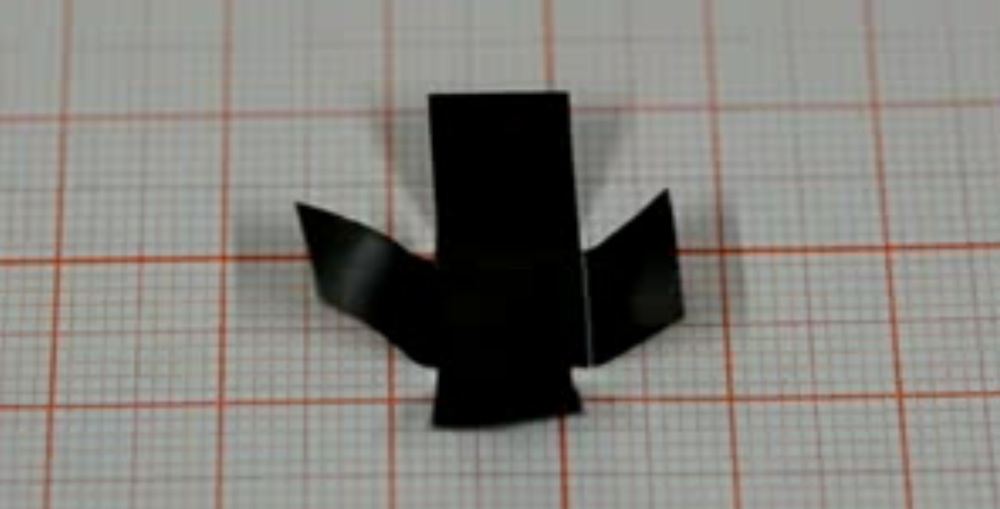
Origami-inspired graphene paper that can fold itself could be used to create anything from miniature robots to artificial muscles, according to a new study.
Scientists from Donghua University in China have demonstrated that gently heating a sheet of graphene paper, which is extraordinarily strong (about 200 times stronger than steel by weight), could make it fold into a device that is able to walk forward and backward. And, in a first for this kind of self-folding material, they showed it could also change directions.
The research could help scientists develop self-folding structures and devices for modern applications, including wirelessly controlled micro robots, artificial muscles and devices for tissue engineering, said Jiuke Mu, a Ph.D. student at Donghua University and one of the material’s inventors. [The 6 Strangest Robots Ever Created]
"In the near future, it even could bring changes to people's lives," Mu told Live Science, giving the example of smart clothing, "which could change its shape and style in response to body temperature, environmental changes or other gentle stimulations.”
The technology relies on specially treating sections of graphene paper so that they naturally absorb water vapor from the atmosphere, the researchers said. When the paper is heated, this water is released, causing those sections to shrink and bend. When the heating stops, this process is reversed.
Careful placement of these treated sections made it possible to create various self-folding objects, including the walking device, a self-assembling box and an artificial hand that can grasp and hold objects five times heavier than itself.
The researchers determined the 3D shape into which the paper folds simply by altering the placement and width of the specially treated areas, with wider sections bending more than narrower ones.
Sign up for the Live Science daily newsletter now
Get the world’s most fascinating discoveries delivered straight to your inbox.
The caterpillarlike walking device was created by building a rectangular sheet of graphene paper with three treated bands running across it that got progressively wider from front to back. When the sheet was lit with a near-infrared light, the bending of these sections caused the sheet to curve into an arch.
But the varying widths of these sections meant the rear of the sheet curved more than the front, so when the light was switched off and the sheet relaxed, the device stretched forwards. The response of the material was so quick that five of these steps took only 2 seconds. By heating just one side of the sheet, the researchers were also able to make the device turn, because one side would bend more than the other.
Self-folding materials have become a major topic of research in recent years, with particular focus on so-called active polymers, materials that convert other forms of energy into mechanical work. But studies to date have often relied on electrical circuitry, unusual environmental conditions or complicated combinations of materials, which tend to be fragile.
By making their devices entirely out of graphene — a one-atom-thick sheet of carbon that is both incredibly strong and very stretchy — Mu and his colleagues created a device that was still 90 percent effective, even after being folded 500 times. The material also has an energy-conversion rate of 1.8 percent, which is considerably better than the 1 percent or lower achieved by other active polymers, Mu said. [7 Cool Uses of 3D Printing in Medicine]
In addition to having the potential to inspire self-folding devices, the researchers said graphene paper could eventually be used to create artificial muscles. The stress generated by one of the paper devices was nearly two orders of magnitude higher than that of mammalian skeletal muscles, the researchers said.
"Compared with other kinds of self-folding materials, the all-graphene-based structure is simpler, its response behavior is faster and the output is more efficient," Mu said. "More importantly, its origami and walking behavior is remotely controlled."
Pure graphene can be costly and time-consuming to create, though, so the researchers used graphene oxide (GO) to create their paper. This material, Mu said, costs as little 1 Yuan (or 16 cents in U.S. dollars) per gram.
The researchers used GO nanosheets as building blocks to construct larger sheets before carrying out what's known as a reduction reaction to remove oxygen atoms from the GO. This converts the material into reduced GO (rGO), which does not have such impressive properties as pristine graphene, but still shares many of the same characteristics.
Crucially, though, the scientists treated areas of the GO paper with polydopamine (PDA) before carrying out the reduction reaction, which prevented these sections of GO from being reduced. Unlike the rest of the paper, these specially treated areas readily absorb water vapor, giving them the ability to bend.
The team's results were described in a paper published Nov. 6 in the journal Science Advances, but Mu said there is still a ways to go before any practical applications of the paper can be realized.
"We believe there is still room for improvement in the energy-conversion efficiency," he said. "Secondly, we think that as the device scales down in size, especially to nanoscale, its properties and origami performance would change significantly. Therefore we are also interested in developing a nano-size all-graphene origami device."
Follow Live Science @livescience, Facebook & Google+. Original article on Live Science.










